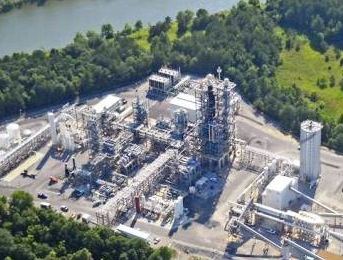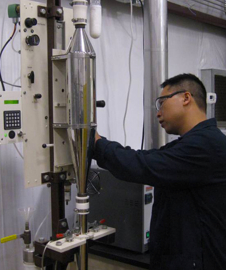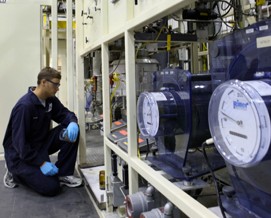After hundreds of millions of dollars in venture capital funding and stock market IPOs, second-generation biofuels still hadn't moved beyond small pilot plants, despite rosy federal projections. Suddenly that's all changed - the energy landscape shifting, maybe quaking. In mid November, KiOR, a second-generation biofuels startup, hit a major industry milestone: its new $220 million Mississippi plant is producing biocrude from local wood chips and will ship "drop in" fuels by December, which, CEO Fred Cannon said in an earnings call, would be "the world's first cellulosic gasoline and diesel fuel," as other US biofuel companies, including Gevo and Amyris, have stumbled. He went on to say,"This validates KiOR's proprietary biomass fluid catalytic cracking technology at commercial scale."

Missed targets and huge loses
On schedule, on budget, and at scale; skeptics shocked, and short-sellers blind-sided, says Jim Lane in Biofuels Digest. The whole sector had been plagued with problems. Range Fuels went bankrupt in late 2011. Gevo, now 87% off its IPO high, temporarily halted production in September, its new isobutanol production system delivering low yields. Amyris, down 82%, has also stopped down to tweak fermentation. And KiOR, the youngest of the three companies, was sucked into this down draft, losing 49% of its market value since its June IPO. There were other troubles. Years earlier, the US Government had anticipated more technical progress and set an overly ambitious goal of 250 million gallons of cellulosic biofuel for 2011 and 500 million gallons for 2012. Without any production yet, the EPA, finally realistic, cut that to just six million gallons for this year. Last summer's drought also hurt alternative fuels. Governors, oil refiners needing blend stock and other companies hurt by high corn prices have asked the agency to waive its requirements for ethanol and other renewable fuels. So industry-wide pessimism had set in.
ChemE Paul O'Conner's single step fast pyrolysis technology
But KiOR's plant, according to Biofuels Digest, is on target to hit its goals. With further catalyst improvements and larger scale, cost per gallon should drop to $5.95 by 2013, $3.73 in 2014, finally reaching the holy grail in 2015, below $3.00 - possibly $2.62 per gallon.

KiOR has already lined up three companies, FedEx and a joint venture of Weyerhauser and Chevron, to buy its output. Transforming 500 tons of biomass a day, the new plant, smaller than typical oil refineries, will produce more than 13 million gallons of gasoline and diesel a year at full capacity. The start-up has adapted a method from the refining industry that uses standard components and a proprietary catalyst to convert cellulose into oil. Byproducts are water, coke, and gases, according to the company; then the catalyst is separated from the oil and the coke is burned off, so the catalyst can be used again. Using off-the-shelf equipment, the oil is finally refined into gasoline, ultra low sulfur diesel, and low sulfur fuel oil. Although the process is feedstock agnostic, the plant will use southern yellow pine, which has a sustainable surplus of 59,000 tons per day - enough at 90 gallons per ton to support 1.9 billion gallons of fuel. This technology quickly has moved from the research stage to commercial production in just five years. Watch a CGI virtual tour, produced before the new plant opened: KiOR began in 2007 after a call by Paul O'Conner, a chemical engineer in the Netherlands, to Vinod Khosla, a well-known renewable fuels venture capitalist, who had already made big bets on US startups Amyris and Gevo. O'Conner explained that he felt first generation biofuels were a mistake: for years he'd laid out (scroll down PDF) the downside at conferences and in articles: limited supply, the ethanol blend wall, and competition with edible feedstocks. In 2005 after working for twenty years on oil refining catalysts at Shell, Akzo Nobel, he founded BIOeCON to economically convert lignocellulosic biomass waste, and then developed several breakthrough concepts, all laid down in several key patents.
Running into start up problems
Over the phone, O'Conner pitched a hydrocarbon fuel created by catalysts and non-food biomass rather than the alcohol-based ethanol produced by Gevo and Amryis. After Khosla realized this "drop-in" fuel could take advantage of traditional refinery techniques, could use existing pipelines, and could meet the world's need for petroleum alternatives, he jumped to provide the early rounds of funding, while O'Conner and BIOeCON provided the intellectual property for its

"biomass catalytic cracking technology," which has been used in the oil industry for decades. KiOR's Texas pilot plant proved that cellulosic feedstock could be converted into renewable crude oil through a scalable, relatively inexpensive catalytic process. But, according to the company website, after the initial approach failed, the new team re-invented the entire process. Encouraged by the pilot success, and in spite of the worst economic crisis since the Great Depression, after just a few months of testing, work began on a larger - 400 times - demonstration unit. On New Year's Day, 2010, that unit began operation, with the capacity to process 10 dry tons of wood and produce up to 15 barrels of product per day.

The 2012 commercial plant in Mississippi unit is less than 50 times further scale up, which is considered a small compared to typical FCC units. The five year path from idea to commercialzation produced 70 patents and over 2,000 pending IP claims. The company has begun work on a larger facility in Natchez, Mississippi, clearing the site and securing permits, and will eventually process three times the amount of biomass, or 1,500 dry tons per day, as the Columbus plant.


